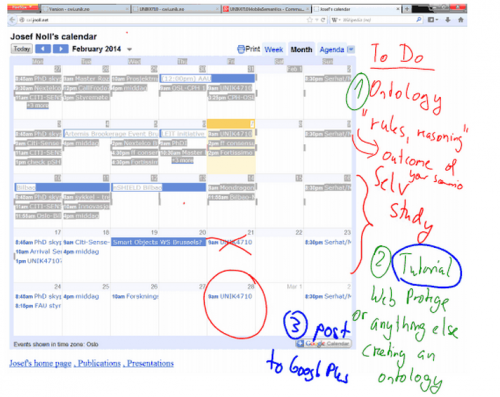Difference between revisions of "Self study: Draw ontologies and rules"
Josef.Noll (Talk | contribs) (Created page with "{{Lecture |Course=UNIK4710, UNIK9710, |Title=Self study: Draw ontologies and rules |Lecture date=2014/02/20 |Lecturer=n.n. |Objective=Prepare a graphical and verbal understa...") |
Josef.Noll (Talk | contribs) |
||
| Line 1: | Line 1: | ||
{{Lecture | {{Lecture | ||
| − | |Course=UNIK4710, UNIK9710, | + | |Course=UNIK4710, UNIK9710, |
| − | |Title=Self study: Draw ontologies and rules | + | |Title=Self study: Draw ontologies and rules |
| − | |Lecture date=2014/02/ | + | |Lecture date=2014/02/26 |
|Lecturer=n.n. | |Lecturer=n.n. | ||
|Objective=Prepare a graphical and verbal understanding of your scenario | |Objective=Prepare a graphical and verbal understanding of your scenario | ||
Latest revision as of 18:55, 18 January 2015
| Wiki for ITS | ||||||
|---|---|---|---|---|---|---|
|
Self study: Draw ontologies and rules
| Course | UNIK4710, UNIK9710 |
|---|---|
| Title | Self study: Draw ontologies and rules |
| Lecture date | 2014/02/26 |
| presented | by n.n. |
| Objective | Prepare a graphical and verbal understanding of your scenario |
| Learning outcomes | Prepare for your scenario:
|
| Pensum (read before) | |
| References (further info) | |
| Keywords |
this page was created by Special:FormEdit/Lecture, and can be edited by Special:FormEdit/Lecture/Self study: Draw ontologies and rules.
ToDo
We discussed three topics for the self study from 10.-21.Feb2014
1) Draw ontologies
Draw your ontologies to gain a better understanding for the relation between entities (called classes in Semantics), e.g. Context -> location, Person -> preferences,
2) Verbal rules
Make your examples very specific, and create a verbal rule that connects the input from certain classes and generates knowledge which you would like to use.
Example: When a person is at home the alarm is off.
3) Study Web Protege
In a later stage of the course you will be asked to implement an simplified model of your ontology in a tool. It is up to you to select a tool.
Examples of tools are: Web Protege, Protege, ....
Note: Kjetil joined the summer school in Semantic Web, and might have material/tutorial. If he or you find something which is worthwhile to share, share it on G+ [1]
next lecture on Friday 28.Feb2014
and please don't forget to block your calendar for the UNIK4710_UNIK9710_Block_Seminar
